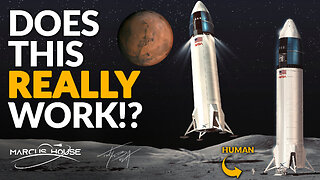Premium Only Content

Moon closep view
The Moon is Earth's only natural satellite and is located at an average distance of about 384,400 kilometers (238,855 miles) from our planet. It has been a prominent and fascinating object in the night sky for millennia. Here's a more detailed description of the Moon:
Size and Appearance:
The Moon has a diameter of about 3,474 kilometers (2,159 miles), making it much smaller than Earth. It appears as a bright, silvery-white disk in the sky when viewed from Earth. The surface of the Moon is covered in various features, including craters, mountains, valleys, and plains.
Phases:
The Moon goes through different phases as it orbits around Earth. These phases are caused by the changing angle between the Moon, Earth, and the Sun. The most well-known phases are the New Moon, First Quarter, Full Moon, and Last Quarter. During a New Moon, the side of the Moon facing Earth is not illuminated by the Sun, making it appear mostly dark. During a Full Moon, the entire side facing Earth is illuminated, giving it a bright appearance.
Surface Features:
The Moon's surface is divided into two main types of terrain: the heavily cratered highlands and the smoother, darker maria (Latin for "seas"). Contrary to the name, maria are not actual seas but rather large, flat plains formed by ancient volcanic activity. The craters are the result of impacts by asteroids and comets over billions of years. Some of the most famous features on the Moon include the Sea of Tranquility (where Apollo 11 landed), the Tycho crater, and the Copernicus crater.
Lack of Atmosphere:
The Moon lacks a significant atmosphere compared to Earth. This absence of atmosphere means there is no weather, wind, or air on the Moon. As a result, there is no erosion or weathering of the surface features, which is why craters from billions of years ago remain relatively well-preserved.
Gravity:
The Moon's gravitational force is about 1/6th that of Earth's, meaning that objects on the Moon weigh much less than they do on Earth. This low gravity allowed astronauts from the Apollo missions to perform spectacular leaps and jumps during their visits to the lunar surface.
Influence on Earth:
The Moon plays a crucial role in Earth's tides due to its gravitational pull on our planet's oceans. It also has had cultural and mythological significance in various cultures throughout history.
Exploration:
The Moon has been the target of multiple robotic missions, including the Apollo program that landed astronauts on its surface between 1969 and 1972. More recently, countries like China and India have conducted successful lunar missions, and there are plans for future human and robotic exploration endeavors.
In summary, the Moon is a captivating celestial object that has intrigued humanity for centuries with its phases, surface features, and potential for scientific exploration.
-
 16:07
16:07
SKAP ATTACK
18 hours ago $5.32 earnedNuggets STEAL Game 1 Behind Jokic Mastery
61.3K11 -
 5:31:41
5:31:41
Big Fitz Plays
6 hours agoWho Gave Me a Chainsword?! | Space Marine 2 Chaos Stream
26.3K1 -
 22:16
22:16
marcushouse
20 hours ago $4.97 earnedFinally, the Starship Info We’ve Been Waiting For… And What We Can Do With It Is Wild!
51.1K20 -
 33:32
33:32
Ohio State Football and Recruiting at Buckeye Huddle
18 hours agoOhio State Football: What Position is the Biggest Question Mark for the Buckeyes?
41.4K2 -
 2:07:19
2:07:19
JahBlessGames
5 hours agoEASTER STREAM TEST
19.3K2 -
 9:30
9:30
VSOGunChannel
23 hours ago $2.05 earnedAdmin Actually Defending the 2nd Amendment?
29.9K12 -
 LIVE
LIVE
Biscotti-B23
8 hours ago $0.57 earned🔴 LIVE REMATCH TOURNAMENT W/ DOTODOYA ⚽ OTSUTSUKI FC VS YOUTUBE ALLSTARS
36 watching -
 44:55
44:55
BEK TV
17 hours agoTARIFFS, TECH TYRANNY, AND PROPHECY: CLAY CLARK EXPOSES THE GLOBAL RESET NO ONE IS TALKING ABOUT
27.1K7 -
 56:09
56:09
TheCommonSenseShow
5 days agoA NEW CONSERVIATIVE MEDIA WILL SOON BE THE LARGEST OUTLET IN THE WORLD
23.8K7 -
 57:50
57:50
Trumpet Daily
2 days ago $5.12 earnedThe Deadly Disease of Forgetting History - Trumpet Daily | Apr. 18, 2025
26.2K5